2007 JEEP PATRIOT oil temperature
[x] Cancel search: oil temperaturePage 174 of 440
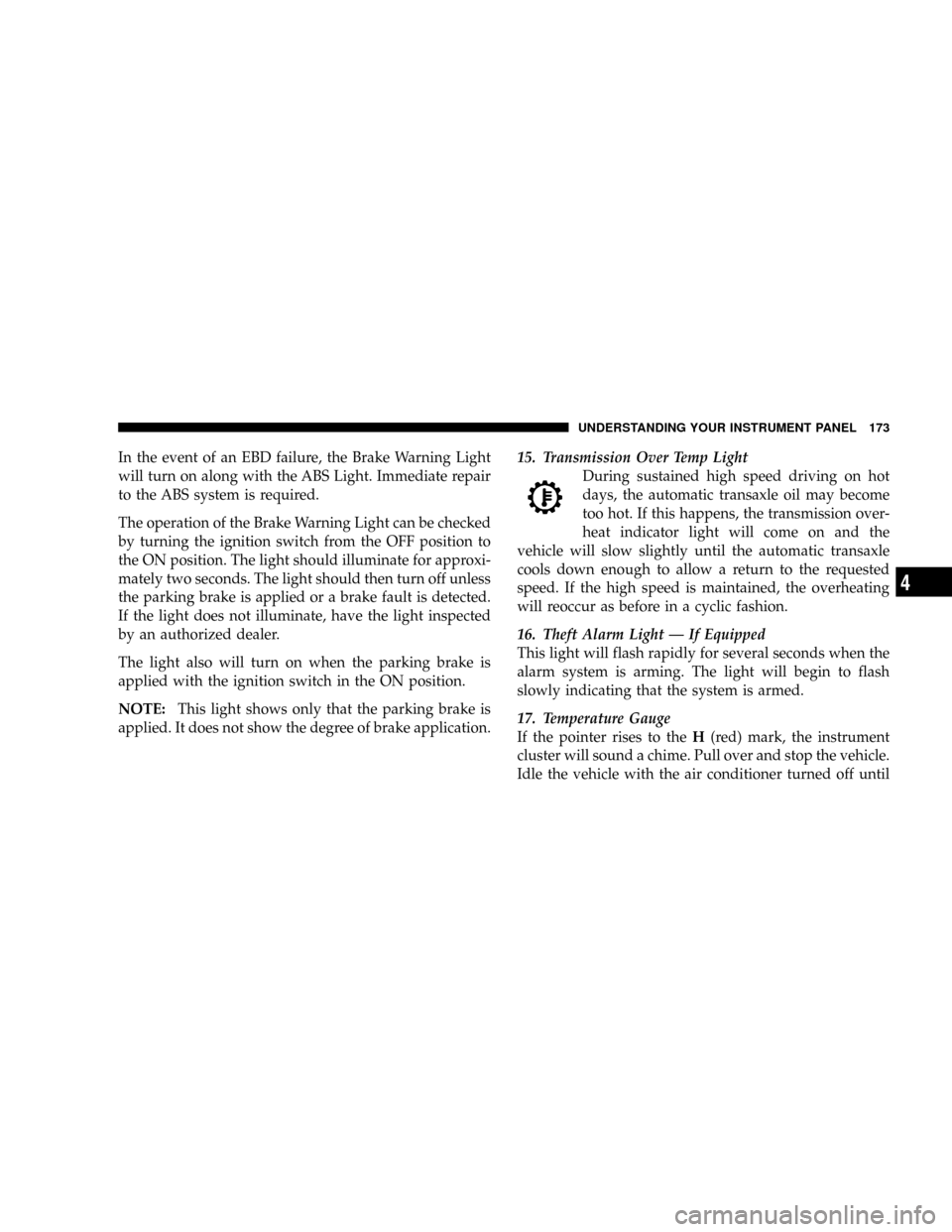
In the event of an EBD failure, the Brake Warning Light
will turn on along with the ABS Light. Immediate repair
to the ABS system is required.
The operation of the Brake Warning Light can be checked
by turning the ignition switch from the OFF position to
the ON position. The light should illuminate for approxi-
mately two seconds. The light should then turn off unless
the parking brake is applied or a brake fault is detected.
If the light does not illuminate, have the light inspected
by an authorized dealer.
The light also will turn on when the parking brake is
applied with the ignition switch in the ON position.
NOTE:This light shows only that the parking brake is
applied. It does not show the degree of brake application.15. Transmission Over Temp Light
During sustained high speed driving on hot
days, the automatic transaxle oil may become
too hot. If this happens, the transmission over-
heat indicator light will come on and the
vehicle will slow slightly until the automatic transaxle
cools down enough to allow a return to the requested
speed. If the high speed is maintained, the overheating
will reoccur as before in a cyclic fashion.
16. Theft Alarm Light Ð If Equipped
This light will flash rapidly for several seconds when the
alarm system is arming. The light will begin to flash
slowly indicating that the system is armed.
17. Temperature Gauge
If the pointer rises to theH(red) mark, the instrument
cluster will sound a chime. Pull over and stop the vehicle.
Idle the vehicle with the air conditioner turned off until
UNDERSTANDING YOUR INSTRUMENT PANEL 173
4
Page 349 of 440
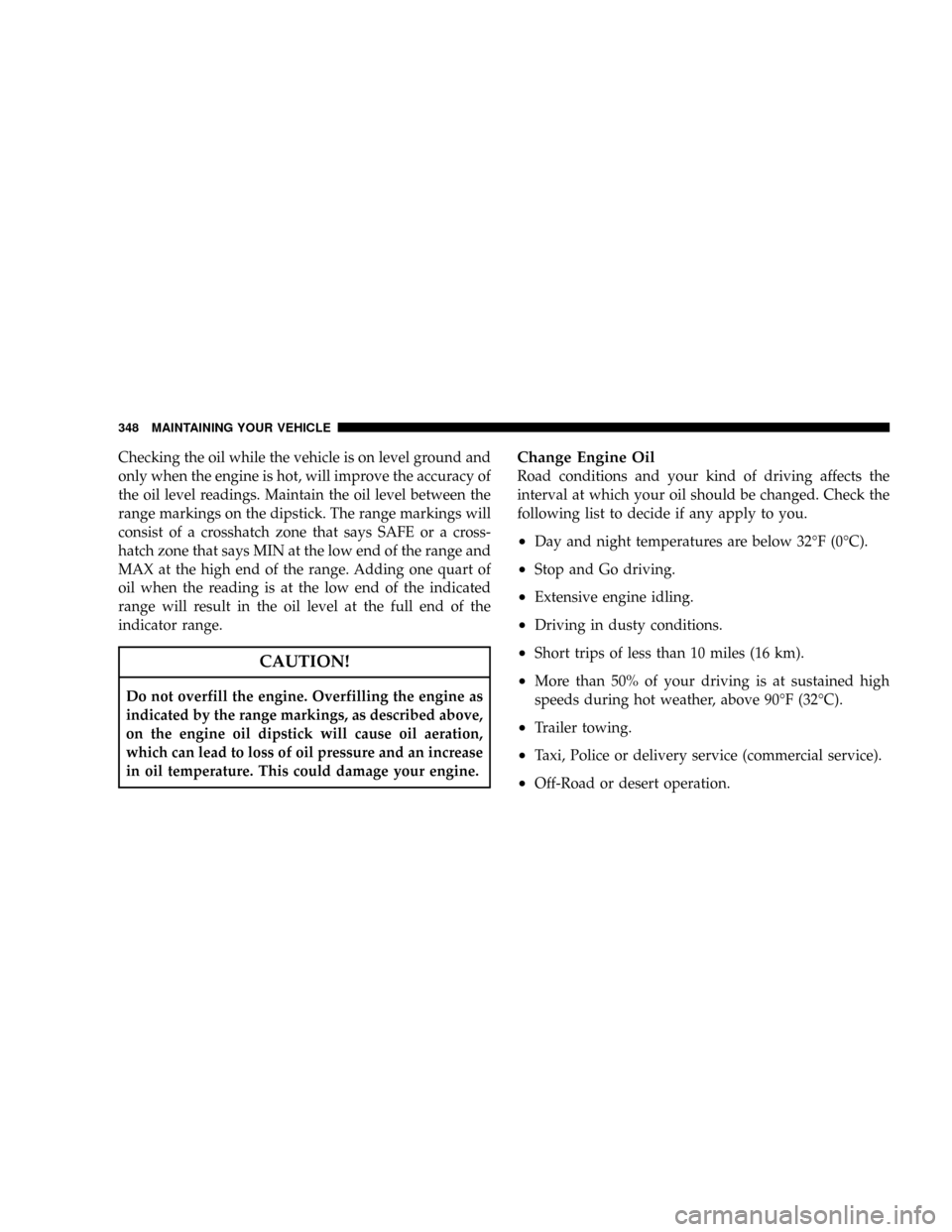
Checking the oil while the vehicle is on level ground and
only when the engine is hot, will improve the accuracy of
the oil level readings. Maintain the oil level between the
range markings on the dipstick. The range markings will
consist of a crosshatch zone that says SAFE or a cross-
hatch zone that says MIN at the low end of the range and
MAX at the high end of the range. Adding one quart of
oil when the reading is at the low end of the indicated
range will result in the oil level at the full end of the
indicator range.
CAUTION!
Do not overfill the engine. Overfilling the engine as
indicated by the range markings, as described above,
on the engine oil dipstick will cause oil aeration,
which can lead to loss of oil pressure and an increase
in oil temperature. This could damage your engine.
Change Engine Oil
Road conditions and your kind of driving affects the
interval at which your oil should be changed. Check the
following list to decide if any apply to you.
²Day and night temperatures are below 32ÉF (0ÉC).
²Stop and Go driving.
²Extensive engine idling.
²Driving in dusty conditions.
²Short trips of less than 10 miles (16 km).
²More than 50% of your driving is at sustained high
speeds during hot weather, above 90ÉF (32ÉC).
²Trailer towing.
²Taxi, Police or delivery service (commercial service).
²Off-Road or desert operation.
348 MAINTAINING YOUR VEHICLE
Page 350 of 440
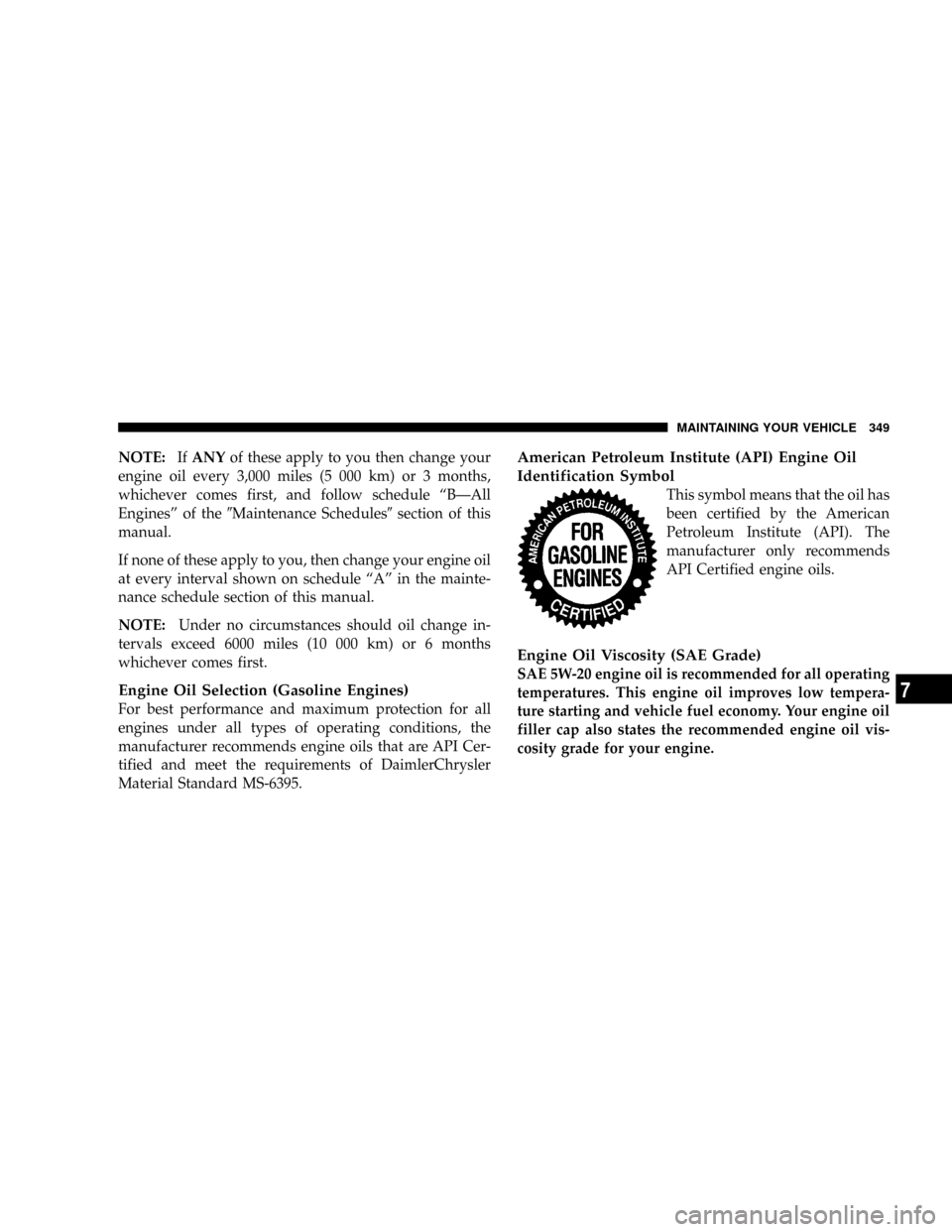
NOTE:IfANYof these apply to you then change your
engine oil every 3,000 miles (5 000 km) or 3 months,
whichever comes first, and follow schedule ªBÐAll
Enginesº of the9Maintenance Schedules9section of this
manual.
If none of these apply to you, then change your engine oil
at every interval shown on schedule ªAº in the mainte-
nance schedule section of this manual.
NOTE:Under no circumstances should oil change in-
tervals exceed 6000 miles (10 000 km) or 6 months
whichever comes first.
Engine Oil Selection (Gasoline Engines)
For best performance and maximum protection for all
engines under all types of operating conditions, the
manufacturer recommends engine oils that are API Cer-
tified and meet the requirements of DaimlerChrysler
Material Standard MS-6395.
American Petroleum Institute (API) Engine Oil
Identification Symbol
This symbol means that the oil has
been certified by the American
Petroleum Institute (API). The
manufacturer only recommends
API Certified engine oils.
Engine Oil Viscosity (SAE Grade)
SAE 5W-20 engine oil is recommended for all operating
temperatures. This engine oil improves low tempera-
ture starting and vehicle fuel economy. Your engine oil
filler cap also states the recommended engine oil vis-
cosity grade for your engine.
MAINTAINING YOUR VEHICLE 349
7
Page 367 of 440
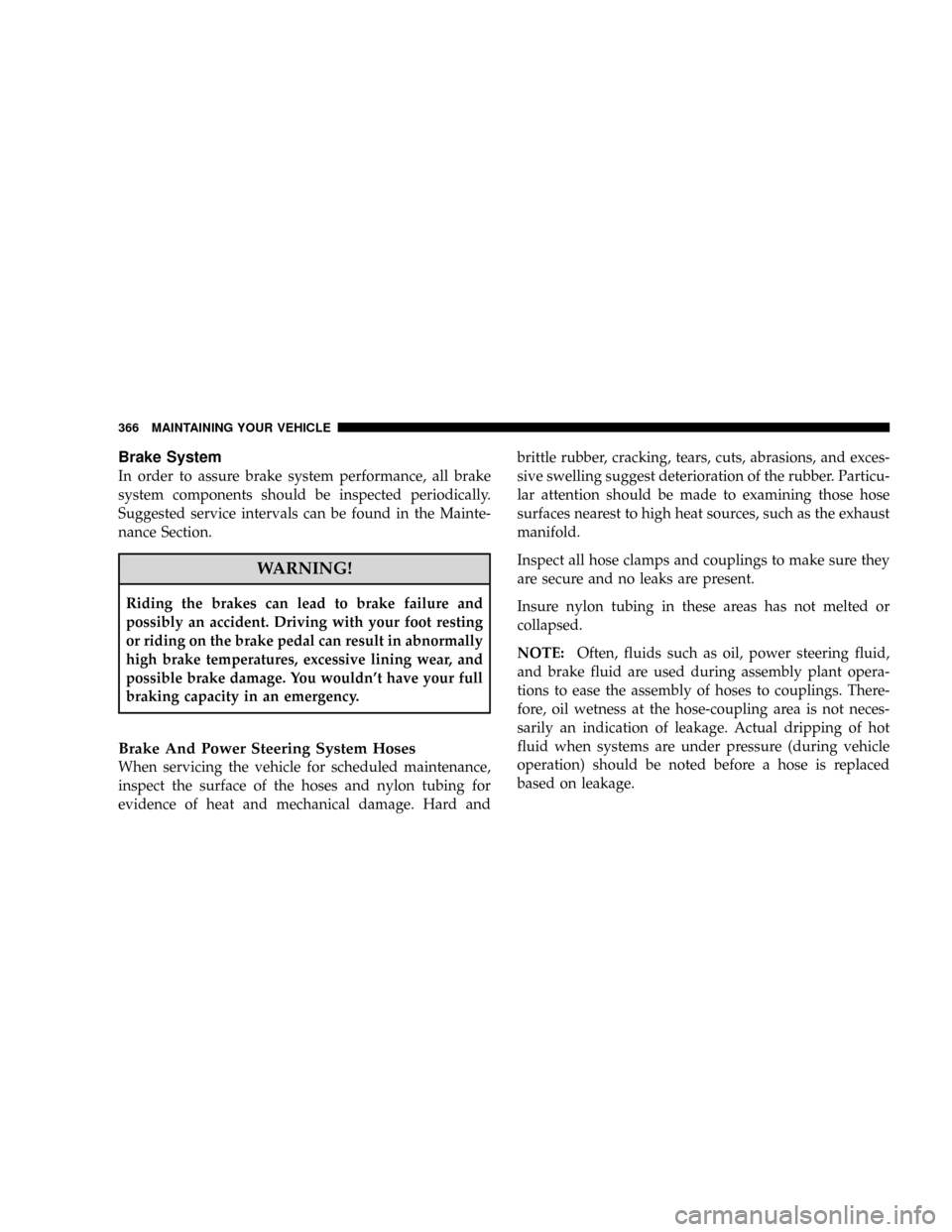
Brake System
In order to assure brake system performance, all brake
system components should be inspected periodically.
Suggested service intervals can be found in the Mainte-
nance Section.
WARNING!
Riding the brakes can lead to brake failure and
possibly an accident. Driving with your foot resting
or riding on the brake pedal can result in abnormally
high brake temperatures, excessive lining wear, and
possible brake damage. You wouldn't have your full
braking capacity in an emergency.
Brake And Power Steering System Hoses
When servicing the vehicle for scheduled maintenance,
inspect the surface of the hoses and nylon tubing for
evidence of heat and mechanical damage. Hard andbrittle rubber, cracking, tears, cuts, abrasions, and exces-
sive swelling suggest deterioration of the rubber. Particu-
lar attention should be made to examining those hose
surfaces nearest to high heat sources, such as the exhaust
manifold.
Inspect all hose clamps and couplings to make sure they
are secure and no leaks are present.
Insure nylon tubing in these areas has not melted or
collapsed.
NOTE:Often, fluids such as oil, power steering fluid,
and brake fluid are used during assembly plant opera-
tions to ease the assembly of hoses to couplings. There-
fore, oil wetness at the hose-coupling area is not neces-
sarily an indication of leakage. Actual dripping of hot
fluid when systems are under pressure (during vehicle
operation) should be noted before a hose is replaced
based on leakage.
366 MAINTAINING YOUR VEHICLE
Page 396 of 440

Schedule ªBº
Follow schedule ªBº if you usually operate your vehicle
under one or more of the following conditions.
²Day or night temperatures are below 32 ÉF (0 ÉC).
²Stop and go driving.
²Extensive engine idling.
²Driving in dusty conditions.
²Short trips of less than 10 miles (16 km).
²More than 50% of your driving is at sustained high
speeds during hot weather, above 90 ÉF (32 ÉC).
²Trailer towing.
²Taxi, police, or delivery service (commercial service).
²Off-road or desert operation.
²Heavy Loading
NOTE:IfANYof these apply to you then change your
engine oil every 3,000 miles (5 000 km) or 3 months,
whichever comes first and follow schedule ªBº of the
9Maintenance Schedules9section of this manual.
NOTE:IfANYof these apply to you then change your
coolant every 102,000 miles (170 000 km) or 60 months,
whichever comes first and follow schedule ªBº of the
9Maintenance Schedules9section of this manual.
SCHEDULE ªBº 395
8
M
A
I
N
T
E
N
A
N
C
E
S
C
H
E
D
U
L
E
S
Page 427 of 440
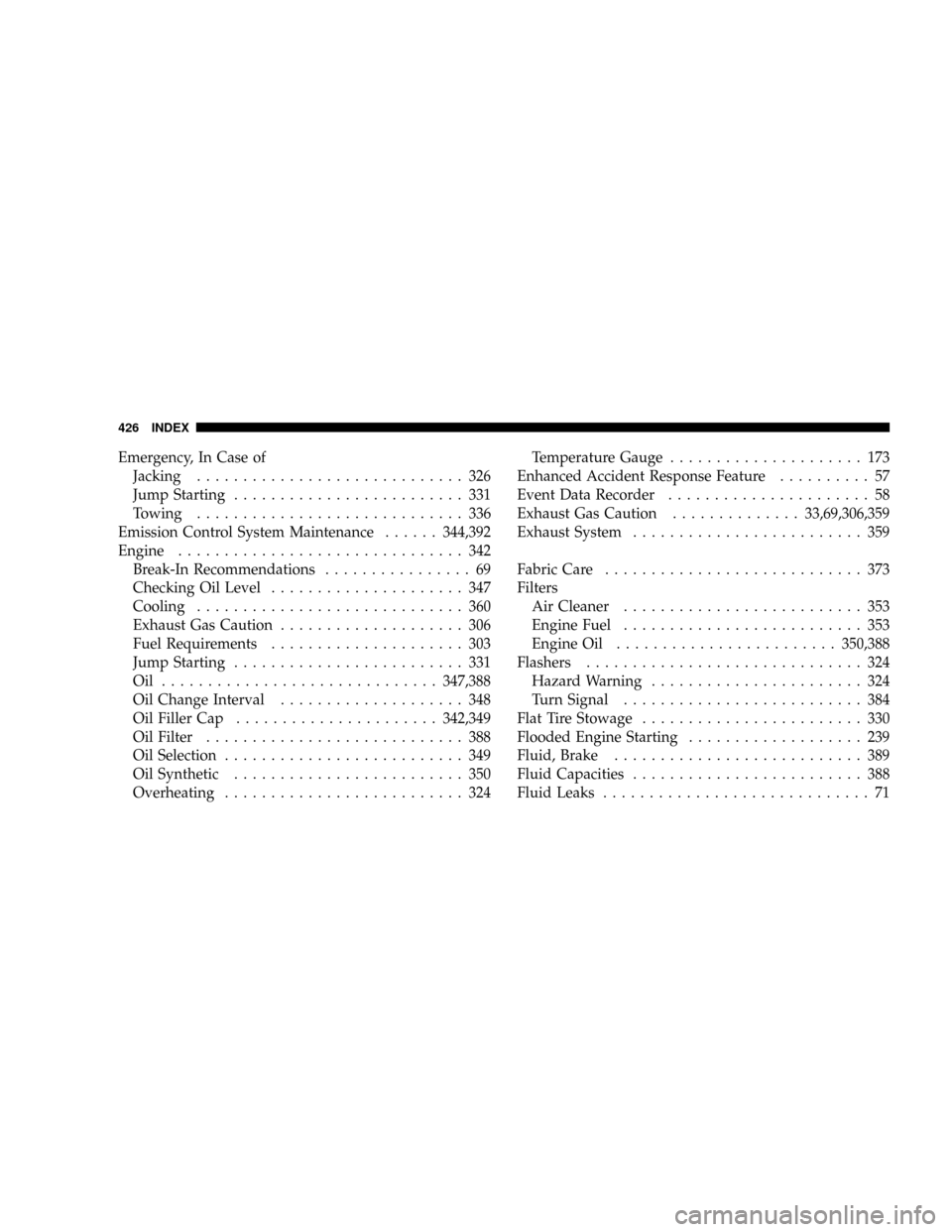
Emergency, In Case of
Jacking............................. 326
Jump Starting......................... 331
Towing............................. 336
Emission Control System Maintenance......344,392
Engine............................... 342
Break-In Recommendations................ 69
Checking Oil Level..................... 347
Cooling............................. 360
Exhaust Gas Caution.................... 306
Fuel Requirements..................... 303
Jump Starting......................... 331
Oil ..............................347,388
Oil Change Interval.................... 348
Oil Filler Cap......................342,349
Oil Filter............................ 388
Oil Selection.......................... 349
Oil Synthetic......................... 350
Overheating.......................... 324Temperature Gauge..................... 173
Enhanced Accident Response Feature.......... 57
Event Data Recorder...................... 58
Exhaust Gas Caution..............33,69,306,359
Exhaust System......................... 359
Fabric Care............................ 373
Filters
Air Cleaner.......................... 353
Engine Fuel.......................... 353
Engine Oil........................350,388
Flashers.............................. 324
Hazard Warning....................... 324
Turn Signal.......................... 384
Flat Tire Stowage........................ 330
Flooded Engine Starting................... 239
Fluid, Brake........................... 389
Fluid Capacities......................... 388
Fluid Leaks............................. 71
426 INDEX
Page 436 of 440
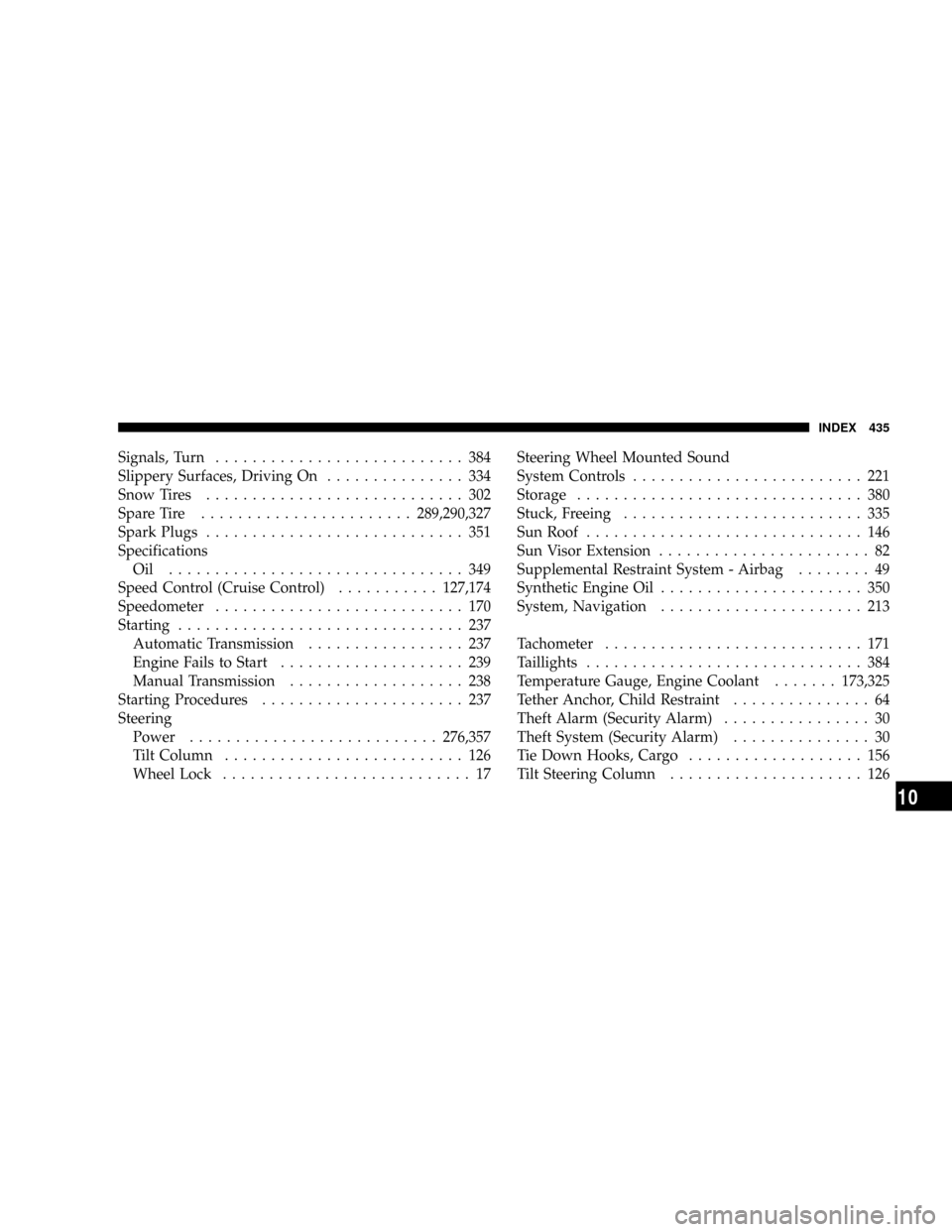
Signals, Turn........................... 384
Slippery Surfaces, Driving On............... 334
Snow Tires............................ 302
Spare Tire.......................289,290,327
Spark Plugs............................ 351
Specifications
Oil ................................ 349
Speed Control (Cruise Control)...........127,174
Speedometer........................... 170
Starting............................... 237
Automatic Transmission................. 237
Engine Fails to Start.................... 239
Manual Transmission................... 238
Starting Procedures...................... 237
Steering
Power...........................276,357
Tilt Column.......................... 126
Wheel Lock........................... 17Steering Wheel Mounted Sound
System Controls......................... 221
Storage............................... 380
Stuck, Freeing.......................... 335
Sun Roof.............................. 146
Sun Visor Extension....................... 82
Supplemental Restraint System - Airbag........ 49
Synthetic Engine Oil...................... 350
System, Navigation...................... 213
Tachometer............................ 171
Taillights.............................. 384
Temperature Gauge, Engine Coolant.......173,325
Tether Anchor, Child Restraint............... 64
Theft Alarm (Security Alarm)................ 30
Theft System (Security Alarm)............... 30
Tie Down Hooks, Cargo................... 156
Tilt Steering Column..................... 126
INDEX 435
10